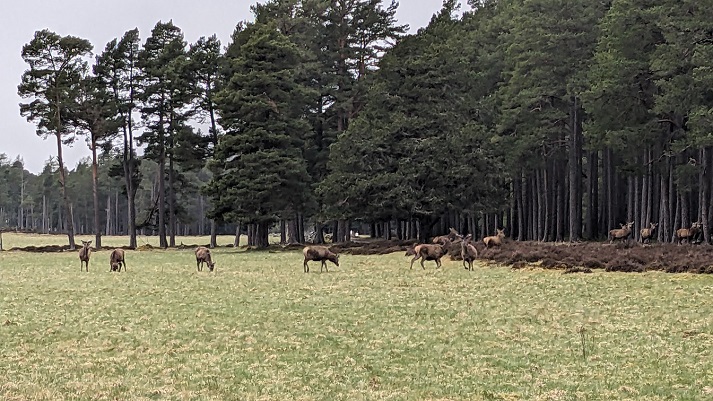
Following my last post on deer density (see here), which was prompted by the 200+ deer I had seen on the Quoich flats on 3rd May and which took a theoretical look at what 10, 8 or 6 deer per square km means for the natural environment, this post relates those arguments to what is happening in the Upper Deeside and Donside Deer Management Group and on the ground on the sporting half of Mar Lodge Estate which is owned and managed by the National Trust for Scotland (NTS).
Deer density in the Upper Deeside and Donside Deer Management Group
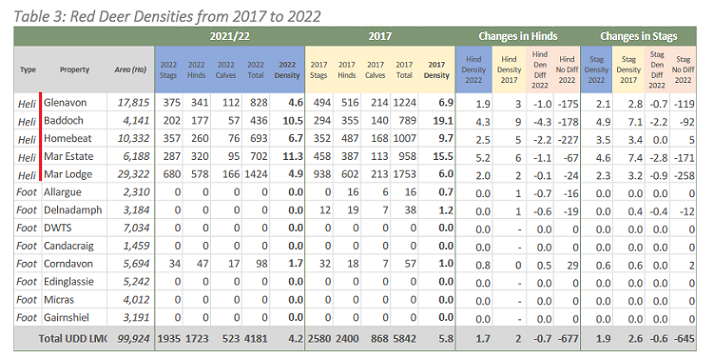
The first and most important point to appreciate about this table from the Deer Management Plan (see here) is about the landownership. Five out of the 13 properties listed are actually part of the Invercauld Estate and in total area are almost as large as Mar Lodge. Two of these, Baddoch and Homebeat, are reported as having high deer densities – well above the 2 deer per square kilometre which allows nature to regenerate – while the other three, Corndavon, Micras and Gairnshiel, which are subject to intensive grouse moor management are reported as having either no or almost no deer.
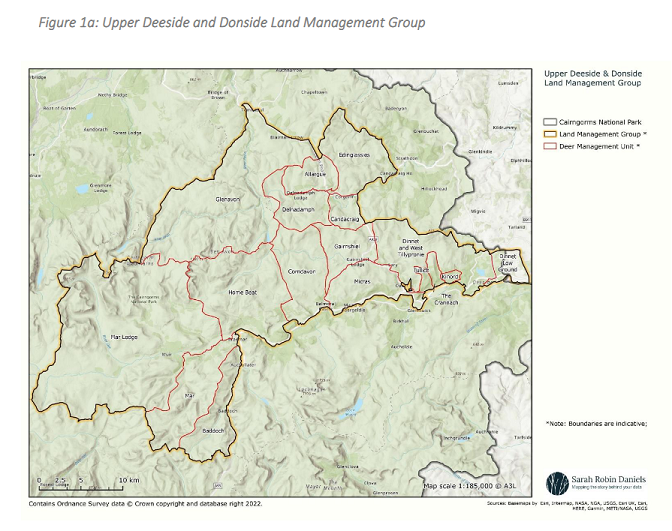
Invercauld has another two land-management units bordering Baddoch, which makes it larger than Mar Lodge, and which are part of the South Grampian Deer Management Group: Glen Callater and Glen Shee. These have both been subject to the Caenlochan Section 7 Agreements through which NatureScot has been half-heartedly trying to reduce deer numbers for over 20 years and where they are now hoping to reduce deer density to 10 per sq km by 2026 (see here). Deer Census data, which I obtained through a freedom of information request, revealed that in August 2019 deer density at Glen Callater was 26 per sq km and at Glen Shee 23.1 per square km. It may well now be less and I have submitted another FOI to NatureScot for data on deer density since then.
The second thing the property table does not show is who manages the sporting rights. Invercauld has for a long time leased out many of the sporting rights on its 7 component parts and Glen Callater was and still is, as I understand it, leased and managed by the Royal Family. At one time the Royal Family also leased the sporting rights at Baddoch, in the Upper Deeside DMG too, but I have been unable to establish if that is still the case.
Consider property ownership and sporting leases as a whole and what the information in the table demonstrates conclusively is that high deer numbers are a matter of “sporting” choice. Two of the largest sporting estate operations in Scotland, Invercauld and the Royal estates at Balmoral and Delnadamph, are responsible for some of the highest numbers of deer in the country and areas where the deer population is non-existent. What determines deer density comes down to whether landowners like King Charles want to shoot deer over the bonnet of a landrover in places like Glen Callater, where they maintain very high numbers of deer, or they want to pop lots of grouse, as at Delnadamph where deer have been eliminated.
While both sporting choices, deer or grouse, have disastrous consequences for the natural environment, arguably land managed to make stalking easy has the greater impact since high deer density usually affects neighbouring landowners too – unless there is a fence, as is the case between Glenavon and Delnadamph and the parts of Invercauld managed for deer and for grouse. It is quite possible, for example, that some of the deer I saw on the Loch Quoich flats had come from places like Glen Callater.
The final point to appreciate about the table is it gives the average deer density for each unit and that distorts the picture for Mar Lodge which is reported as 4.9 per square kilometre. Given that half the estate is now managed as a regeneration zone, where deer density is around 1 per square km (see here), that means that the southern half of Mar Lodge, has a deer density of close to 10 per square kilometre. This fits with what was reported in Andrew Painting’s book on Mar Lodge, Regeneration, published in 2021. While described by NTS as the “moorland zone”, this is a misnomer. Commercial stalking takes place and deer numbers are managed little differently to those on the neighbouring beats of Mar and Invercauld so it should more accurately be described as “the sporting zone”.
What this means is that the large number of deer I saw grazing the Loch Quoich flats could have come from any of the estates in the area which maintain, as a matter of choice, high numbers of red deer including the sporting half of Mar Lodge, i.e NTS are part of the problem.
Deer density of 10 per sq km – the impact on Mar Lodge’s “moorland” zone
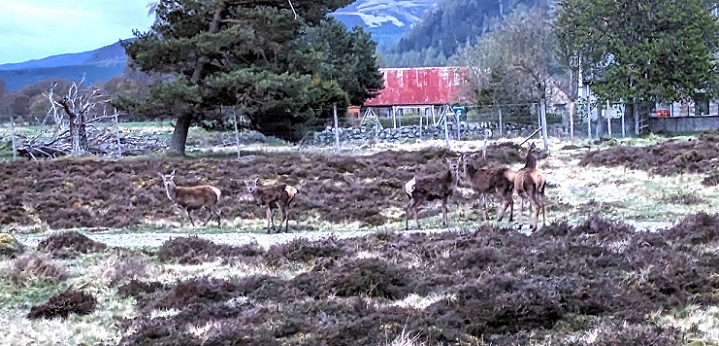
One doesn’t even have to leave the road going round from Inverey, on the boundary between the Mar and Mar Lodge Estate, to Linn of Dee to see the impact of all these deer. The landscape and the deer in both photos tell a tale of how deer have shaped this landscape.
The large flat grassy area in the top photo – perfect for camping – is a consequence of their grazing, as is the mature open woodland which lacks an understorey. Both are attractive and give the area its open feel but such landscapes are naturally unsustainable as they lack young trees to replace the older ones as they start dying. The response, from people who clearly want to maintain the wooded character of the area, has been to plant trees in protective enclosures to prevent them being browsed to death:
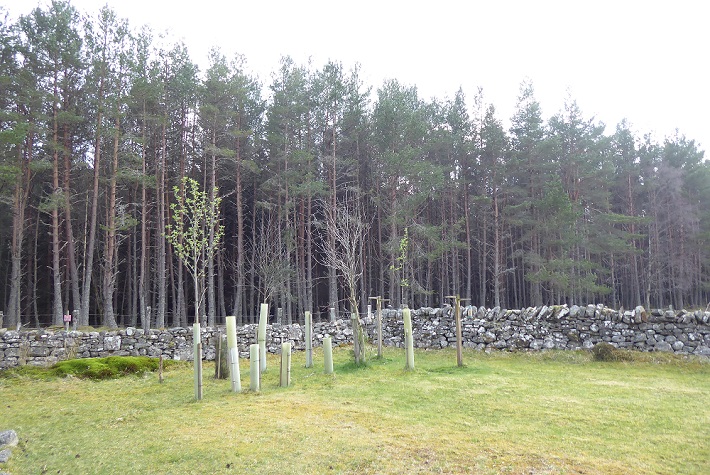
Instead of large landowners, including NTS, reducing deer numbers to levels compatible with survival of gardens or natural regeneration, ordinary people are forced to pick up the compensatory tab.
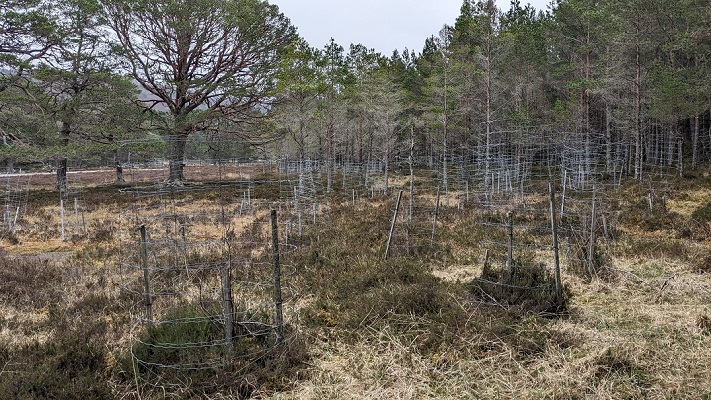
The high grazing pressure besides the road, which is probably a consequence of the high deer numbers on both the Mar and Mar Lodge Estate, has also resulted in significant expense and wasted effort from NTS staff. They, like local people, have been forced into planting trees rather than letting nature do the job as has been happening so successfully in their Regeneration Zone (see here).
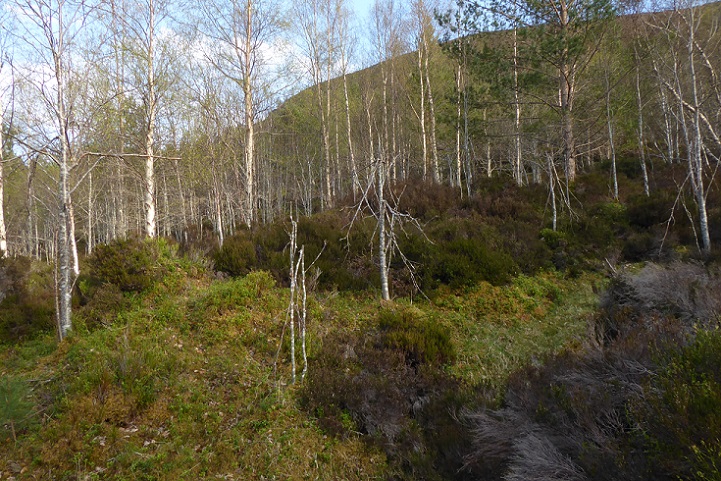
I had never been up the track through the native woodland plantation south of Linn of Dee and jogged up it one evening to take a look. First impressions were favourable with a fair amount of natural regeneration among the planted trees. A little higher up, however, many of the rowan had had their branches snapped off, as happens in many native tree plantations once the deer get in. If NTS don’t want the deer to browse away the understorey too, either they will have to spend significant amounts on repairing the fencing or reduce deer density generally to more sustainable levels.
I did not go up the hills in the Mar Lodge sporting zone to the south of the Dee on my May visit but have been over the Munro Carn Bhac by several routes in the last five years. The higher ground is, in my view, in an even worse state than that down by the Dee contrary to what is claimed in the Upper Deeside Deer Management Plan (see here) which presents the results of Herbivore Impact Assessments from consultants suggesting all is well.
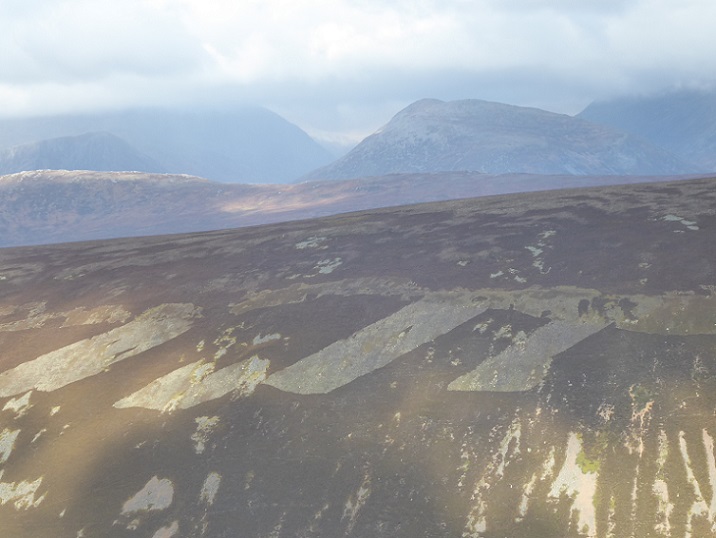
NTS took the decision to stop muirburn in the sporting zone six years ago (see here) and the previously burned strips, like those in the photo, should have provided an opportunity for new plants to get established. That doesn’t appear to be happening and the likely explanation is that any regeneration on the burned patches provides better feed for deer than the surrounding older heather so they graze it preferentially. This is the reason why landowners like King Charlies at Delnadamph don’t want deer on intensively managed grouse moors, they compete with grouse for young heather and even low numbers, let alone densities of 10 per sq km, have a significant impact on the numbers of grouse available to shoot. NTS won’t see much benefit from ending muirburn unless they also reduce deer numbers to 2 per square km.
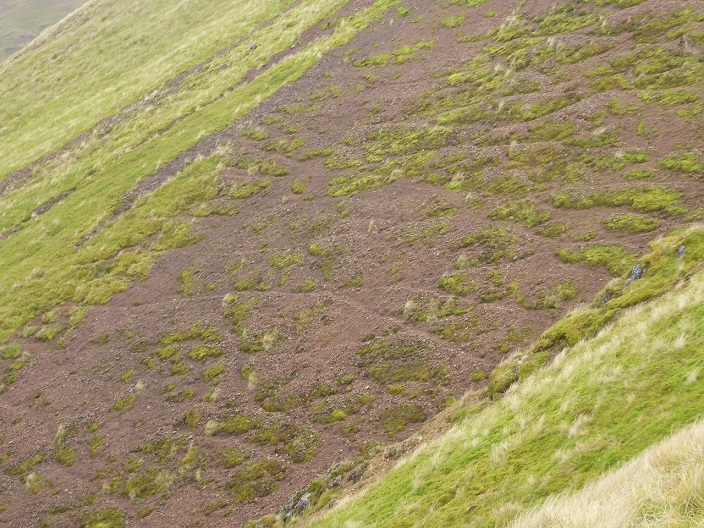
Walking from the Top of the Battery to Carn Bhac in October 2020, dozens of deer streamed across the ridge in front of us. Their impact on the slopes opposite was only too obvious.
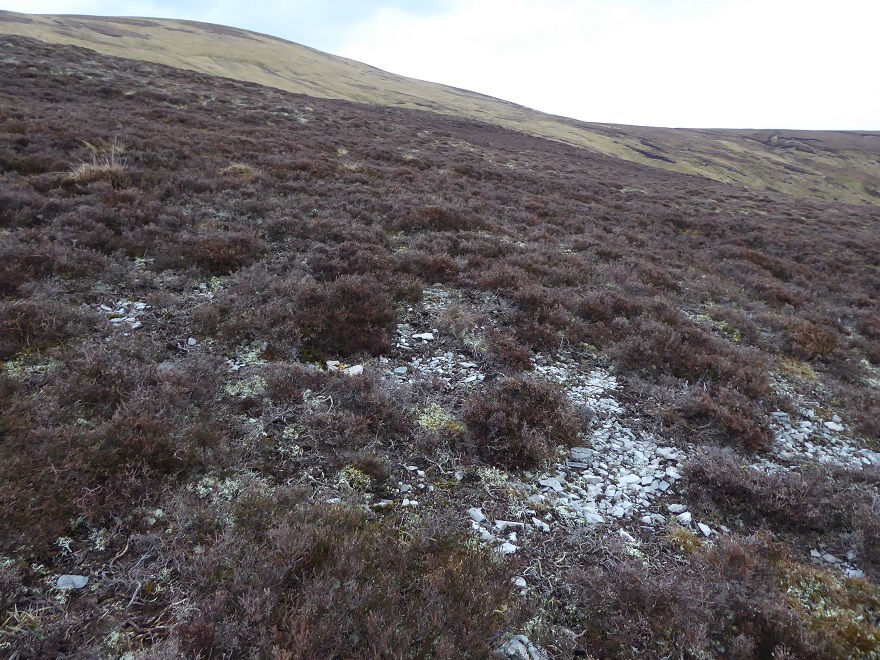
Continual grazing of moorland vegetation can be as damaging to soil/peat development as burning it. If almost all vegetation apart from the woody parts of heather gets eaten, rather dying off naturally, no organic material is left which might enable soils to develop. The result is a barren landscape which absorbs very little carbon from the atmosphere.
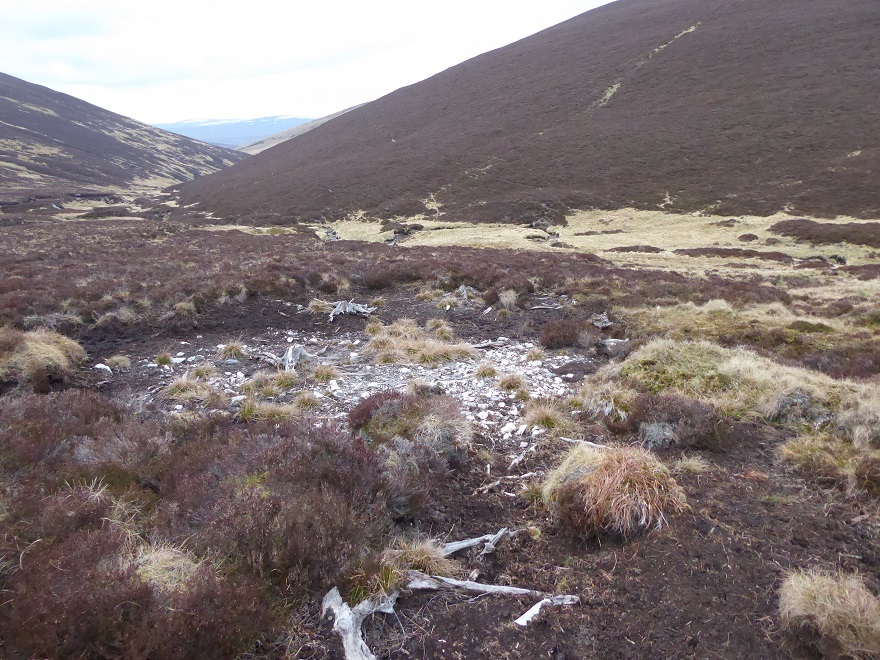
There is something very wrong about NTS restoring degraded peatland on the north side of the River Geldie, an area that has now been classed as part of the regeneration rather than moorland zone, while just a few kilometres away deer are clearly destroying peat.
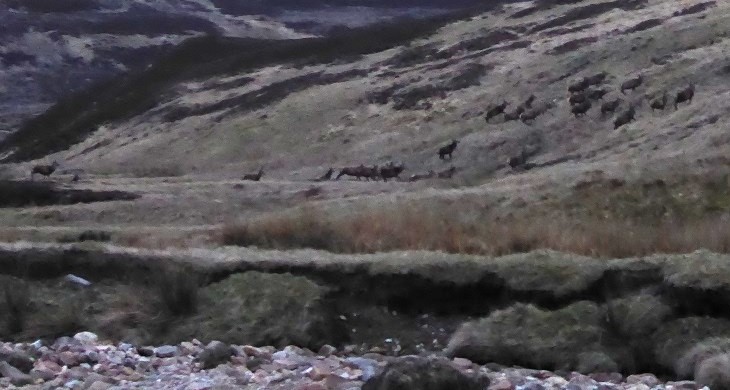
Further down the Allt Bhronn, as night fell, we saw some of the deer. You would not see sights like this or the deer in the photos above in the Mar Lodge regeneration zone. The adverse impacts of NatureScot’s benchmark for an acceptable density of deer on the open hill, 10 per sq km, should be beyond doubt. 10 deer per sq km is not only preventing nature from renewing itself, its continuing to destroy vegetation and soils at the expense of many other forms of wildlife that are not valued by sporting estates.
Sporting politics and the management of the Mar Lodge estate “moorland” zone
There appear to be two main reasons for the high numbers of deer on the moorland zone at Mar Lodge, one practical/financial and the other political.
The practical/financial issue is that deer move and the southern and much of the eastern side of the Mar Lodge Estate borders with estates with high numbers of red deer (Mar, Invercauld, Atholl). If NTS were to cull more deer in the Mar Lodge moorland zone, more would move in, creating an endless task. Some of that is illustrated by this map from the Deeside Deer Management Plan:
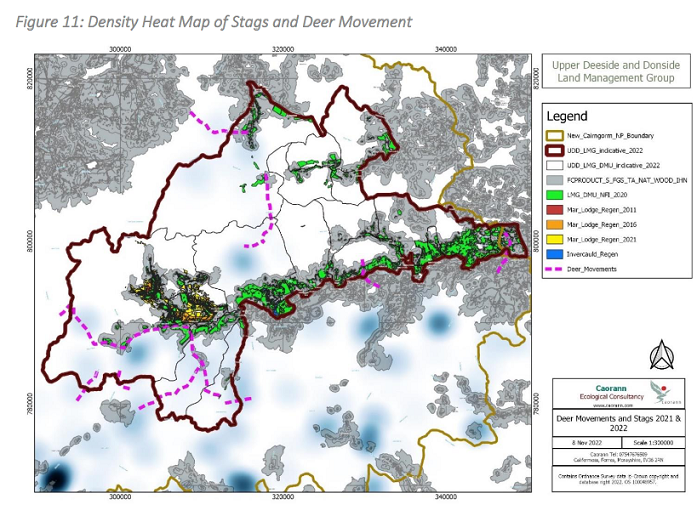
NTS, like other conservation charities but unlike Anders Povlsen – the billionaire who owns Wildland Ltd – simply doesn’t have the financial resources to cull more than their fair share of deer and compensate for what stalking estates are failing to do. That is why these charities are pinning their hopes on the Scottish Government creating Deer Management Nature Restoration Orders which might, after a lengthy resource-consuming process open to legal challenge, force named landholdings or parts thereof to cull more deer…………..only for more deer to move in from further afield. It would be much simpler to set a maximum deer density of 2 per sq km across Scotland.
When NTS started reducing deer in the Regeneration Zone at Mar Lodge to less than 2 per sq km, they came under political pressure from neighbouring sporting estates who complained they were killing “their deer”. This led to the “Independent Review” of the management of Mar Lodge in 2011 (see here) which recommended the erection of a “deflection” deer fence across Sgor Mor. Its primary purpose was NOT to enable natural regeneration north of the River Dee but to save deer from the moorland zone wandering over into the regeneration zone and getting shot. In other words it was designed to maintain high numbers of deer on the moorland zone for sporting purposes.
While ostensibly NTS purchased Mar Lodge for conservation purposes they were only able to do so because of a £4.5m grant from the Easter Trust, a condition of which was the land should continue to be managed as a traditional sporting estate. Six years ago (see here) I explained the links between the Easter Trust, the Salvesen Family and the Royal Family and that influence on the management of Mar Lodge continues to be very strong:
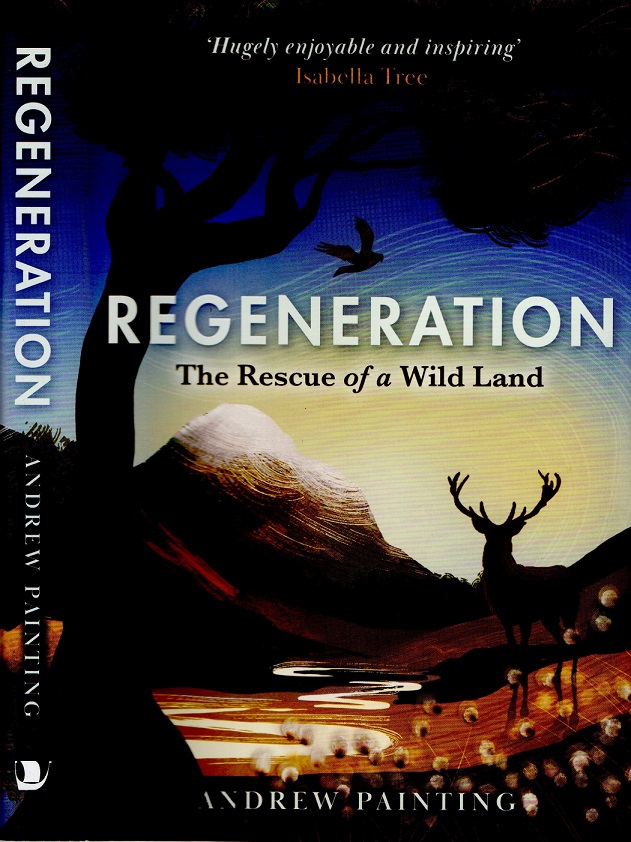
Few people realise but the cover of Andrew Painting’s wonderful book, Regeneration, about the positive things that are happening at Mar Lodge was designed by Abigail Salvesen. A stamp of approval from the family and sporting interests more generally. The book is very cleverly and carefully written but is as important for what it does not say as for what it does. The untold story is the struggle between conservation interests in NTS and sporting interests, led by King Charles.
That struggle has had various different elements and ups and downs. For example, NTS stopped both driven grouse shooting and muirburn for a time after purchasing the estate, was then forced to re-commence these practices in the moorland zone before ending them once more. The 2011 “Independent Review” devoted much space to arguments that fire risks would increase if muirburn was discontinued and, while eventually overturning those arguments, this probably explains why NTS staff are so nervous about recreational camp fires today. One significant fire and the sporting interests might be back, calling for muirburn as a preventive measure.
While sporting interests continue to attempt to influence how NTS manages the moorland zone on Mar Lodge directly, that now risks provoking a backlash from the public as awareness of the damaging impacts of field sports has grown. Sporting interests have now found a much more effective way of doing this, get government agencies to legitimise the high numbers of deer in the moorland zone, while ignoring the impacts, and so stifle conservation initiatives. There are three good examples of how sporting interests are doing this.
1) Deer density and the Mar Lodge National Nature Reserve
Scottish Natural Heritage, which now calls itself NatureScot, and NTS agreed a voluntary Section 7 agreement to reduce deer numbers and prevent damage to the natural environment at Mar Lodge for five years between 2010-11 and 2015-16. Just two years later, in 2017, NatureScot declared the whole of the Mar Lodge Estate a National Nature Reserve despite “significant and ongoing challenges in deer management” (see here).
While nature had been recovering in the Regeneration Zone for around a decade, that certainly hadn’t been happening in the Moorland Zone where deer density, as we have seen, is around 10 per sq km. NatureScot’s decision was completely unwarranted but from a sporting estate perspective was manna from heaven: it helped legitimise high deer densities and promote the damaging consequences of overgrazing as an example of nature at its best (just as burned grouse moors have been protected as Special Areas of Conservation).
2) Deer density on Mar Lodge, the CNPA and the Upper Deeside/Donside Deer Management plan
The Cairngorms National Park Authority in its current National Park Plan has set a target for average density across the National Park of 6-8 on the open hill. While this was an improvement of the target of 10 per sq km in the previous National Park Plan, it totally ignores the fact that deer are very unevenly distributed within the National Park, as demonstrated by the table above. Basically because some grouse moor and conservation managers have reduced deer density to very low levels that means estates managed for traditional stalking don’t need to do anything.
The Upper Deeside and Donside Deer Management Plan provides a good example of the consequences. It reports that “Red deer numbers have been reduced from 8.4 to 4.2 deer per km2 across the LMG [Land Management Group], within the density included in the new Cairngorms National Park Partnership Plan”. What this means is none of the estates responsible for the high numbers of deer I saw on the Quoich flats or along the Dee need to do anything! The National Park Partnership Plan is therefore absolutely no help to conservation owners like the NTS or even traditional estate owners who want to do the right thing but instead help legitimise the new system in which NatureScot maintains 10 deer per sq km is good for nature.
3) Mar Lodge, deer and the east Cairngorms Moorland Partnership
It has always struck me as strange that Mar Lodge is part of the east Cairngorms Moorland Partnership which the CNPA describes as an “innovative approach is seeking to demonstrate that it’s possible to combine delivery of public and private interest outcomes and achieve the successful integration of grouse moors and sporting management with other land uses”.
Perhaps NTS thought it could influence its neighbours? The facts suggest otherwise. How else to explain the distribution and breeding success of raptors across the ECMP which has signally failed to stop raptor persecution (see here)? The latest figures (see here) show that there were 11 confirmed hen harrier breeding attempts in the ECMP area in 2023, of which eight were successful and reared chicks. ALL were on the Mar Lodge Estate! Just why can’t all of King Charles’ land at Balmoral and Delnadamph support a single pair of hen harrier? And while breeding pairs of golden eagle were recorded on every estate in the ECMP in 2023, why were only 3 of 12 nests successful?
The truth about NTS’ membership of the ECMP is it provides another means by which sporting estates landowners like King Charles can influence how Mar Lodge is managed and prevent them doing anything too radical, like reducing deer densities in their Moorland Zone to 2 per square km. This is aided and abetted by the CNPA. The contrast between what Cairngorms Connect, a voluntary association of conservation owners, has achieved without CNPA input and what the ECMP has failed to change is striking.
How to reduce deer density on the moorland zone of Mar Lodge estate?
While the grant from the Easter Trust required NTS to continue traditional stalking on Mar Lodge, there was no condition to maintain high numbers of deer. The continued high density of deer in the moorland zone is therefore a matter of choice. The challenge for NTS is to develop a new model of stalking based on low numbers of deer, i.e with much less guarantee to clients that they will bag a stag or hind.
The abolition of the closed season for stags, which used to cover the period 21st October to 30th June, by the Scottish Government last year (see here) presents an opportunity. The open and closed seasons made stag shooting very difficult, as it was during open season that they tended to be on the open hill and the closed season when they were on the lower more accessible ground. This may have provided another perverse incentive for sporting estates to maintain a high population of stags as in most places stalking did not start until after the summer (and the school holidays) and having trudged over the hill in often poor weather most paying clients expected a return for their efforts, ie an easy shot.
There is no reason now why NTS should not, with the terms of the grant from the Easter Trust, offer commercial stag stalking at times of year when they are much easier to shoot, such as when they descend to the flats along the Dee, but also encourage more people to try hind shooting and encourage the development of a hunting culture such as exists on the continent. There is almost no indication of stalking estates changing their practices at present – the term “traditional stalking” is used for a reason – and NTS could show a lead. Perhaps NTS are already doing this? If so, they are keeping it very secret: there is almost no public information about the stalking they offer on the Mar Lodge website.
Reducing the stag population in the moorland zone would not by itself address the issue of deer density as it only needs one stag to mate with many hinds and the population the next year would be the same. However, it would reduce the average amount of grazing pressure over a year and put pressure on the neighbouring landholdings with high deer densities. The last thing King Charles wants is a conservation organisation like NTS shooting “his” stags.
NTS would be greatly helped in addressing the issue of deer density if NatureScot and the CNPA ceased to support sporting interests and instead directed their efforts to supporting conservation and addressing the climate and nature emergencies. That requires both organisations to adopt a target deer density of 2 per sq km. Were they to do so and make natural regeneration of woodland possible, the Scottish Government could abolish the very damaging forestry grants system and redirect the money being wasted into employing more deer stalkers.

You mention the effects of ending muirburn on wildfires. I’d be very interested to see an article on that.
An excellent dissection of the real issue with sustainable deer management: the power and influence of sporting estate owners and their representatives. Government agencies have always been feart of sporting landowners and tend to kowtow. Seems to be getting worse.
Paying landowners to restore peatland …degraded by their own management or lack thereof, is another abysmal failure to protect the public interest.
spot on, well said.
Gravity has been pulling peat down slopes for centuries. Water, wind and frost heave are stronger forces than deer trampling, which can at least be kept within acceptable bounds. We cant affect these others things though. I do agree that tarting up a few peat haggs is a waste of time. Gravity, wind and water will soon undo it all again.
You are right that gravity has a key role in peatland processes, both in forming it and destroying it. In very acid environments the normal processes by which vegetation decays (bugs, fungi etc) don’t operate – peat is effectively vegetation compressed by gravity and this is why it is just a good store of carbon compared to trees which, when they die, gradually release carbon back into the atmosphere. As the height of the peat grows, however, gravity also helps pull it down hill, breaking up the bog on its downhill edges. Hence the many peatland areas you can see on the top of rounded hills, like mini ice caps but whose edges, when they reach a certain height, are often bare. The peat that is exposed to the atmosphere by this process starts to release water and also oxidises, releasing carbon back into the atmosphere – an entirely natural process. Deer, people and sheep can, however, help accelerate vegetation breakdown on the edge of bogs as the vegetation on the vertical edges is vulnerable to being peeled away from trampling or animals sheltering against it. I totally disagree with you however about the causes of peatland erosion in the middle of bogs. Some is by water but grazing and trampling plays a major role. I need to sort out my photos to illustrate all of this but hope to do a post at some point – I have now amassed a fair amount of evidence of peatbog restoration failing because of deer trampling. Restoring bog in areas where deer density is more than 2 per sq km is a total waste of public money.
That will be an interesting read…. !!